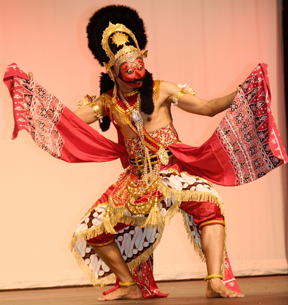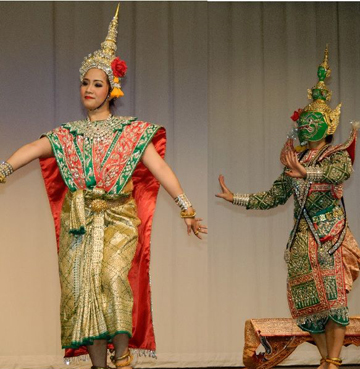
CHICAGO: The 12th Ramayana Dance Drama hosted by International Ramayana Institute of North America on December 2 here at the Rosary High School auditorium brought Indian, Indonesian, and Thai Diasporas together to celebrate their shared cultural legacy.
Chief guests were Consul General of India Ms Neeta Bhushan and her Indonesian counterpart Rosmalawati Chalid, both of whom praised the epic as a national heritage, conserving and transmitting moral values to their respective societies. The proceedings were presided over by Subash C. Pandey from India, who was IRINA’s sixth president (2005-2006).
Ms Bhushan, who personally reads the Indian Ramayana to her children, defined its wealth of artistic outgrowths as a process of give-and-take. The “take” side of this cultural convergence was well demonstrated by the Southeast Asian performances. The Klono Topeng by Tri Kumara Siddhi, who works at the Indonesian consulate, originates in West Java and depicts a powerful king who has become infatuated by a beautiful princess and manifests his evil temperament when unable to fulfill his desire to marry her. Though predating the arrival of Hindu-Buddhist influence, such masked dances were readily incorporated and adapted to narrating the Indian epics.

by an all-female cast
“Floating Lady” episode of the Thai Ramakien was staged by professionals from Somapa Thai Dance Company based in Washington D.C. Originally performed by an all-male cast solely at the royal court, the dance drama was presented before ordinary Americans by a cast of entirely female danseuses.
The Sita wooed here by demon king Ravana turns out to be his own niece Benyakai, who leaves him embarrassed upon quitting her magical disguise. Eventual rescuer of the real Sita, the great white monkey Hanuman thereafter overtakes the fleeing Benyakai in midair to ravish the princess.
This “digression” and apparent inversion of the original suggests the extent to which diverse Southeastern cultures, even as faraway as Cambodia, understood its deeper esoteric meanings well enough to rewrite the epic.
The Balinese Legong Dandaka Sari was presented by the Gamelan Ensemble from University of Illinois at Urbana Champagne’s School of Music. Performed for almost 200 years by angelic prepubescent girls, Legong is a pure highly stylized dance that attempts to capture the graceful essence of feminity. Seven women from Indonesian Performing Arts of Chicago welcomed the audience with the Balinese version of “flower offering” (pushpaanjali).
The Indian component was provided by the large cast from Gauri Jog’s Indian Dance School, who rapidly enacted the story of Lord Rama from birth to the winning of Sita’s hand through a medley of mostly north dances reflecting Kathak, folk, and even Western influences. The marriage was celebrated with the Rajasthani Ghoomar dance by Chicago’s Srujan Dance group.
After the “Ram versus Ravana war” by Indian performers, the grand finale saw troupes from all three countries dancing together across the entire stage.
Prior to the official start, Academy of Thai Classical Music from Chicago’s Wat Dhammaram entertained the gathering audience with five instrumental compositions from different provinces and ethnicities of their home country.
The event was emceed by Rashmi Gandhi, Dhingra and Falguni Gandhi. Dance-related artifacts from Indonesia, Thailand and India were exhibited.
Founded in 2000, IRINA’s presidency rotates among its three constituent Diaspora communities. To supplement the artistic dimension with intellectual depth, IRINA organized three International Ramayana Conferences (in 2001, 2005, and 2010) with Center for Southeast Asian Studies of Northern Illinois University in DeKalb. The first conference, in which scholars from India, Indonesia, Thailand, Myanmar, U.S., Belgium and France participated, also covered the epic traditions in Burma and Philippines (Mindanao). Like the following conference, it was funded by grants from Infinity Foundation.
Newal Kishore Agnihotri, at whose home the IRINA meetings are still held, has been the vision and inspiration behind the organization. He proposed collaboration to the Thai and Indonesian consuls after having watched performances hosted by them more than 15 years ago. His dream is to revive the “Realizing Rama” contemporary dance production and project that premiered at the sixth ASEAN Summit in Vietnam in 1998.

During a month-long stay this summer in Bali, Yogyakarta, and Djakarta, I witnessed Ramayana performances in diverse styles, including shadow puppet theater, and came to appreciate firsthand the abiding love that Indonesians, including and especially Muslims, have for their ancient Indian heritage as a shared wellspring of ever-pertinent human values.
As a specialist of Hindu tradition and South Asian culture, I am also painfully aware, also firsthand, of the contradiction between the above Diaspora veneration and the growing trend in American academia that systematically, even gleefully ‘deconstructs’ Ramayana as an oppressive text justifying the social evils of Hinduism and as stoking ongoing religio-political conflicts, questionable judgments that are nevertheless finding sympathetic elite echoes back in India itself.
With adequate and targeted funding, IRINA could become a platform of choice to reinstate the Ramayana as a unifying force for good across Asia.
Sunthar Visuvalingam






